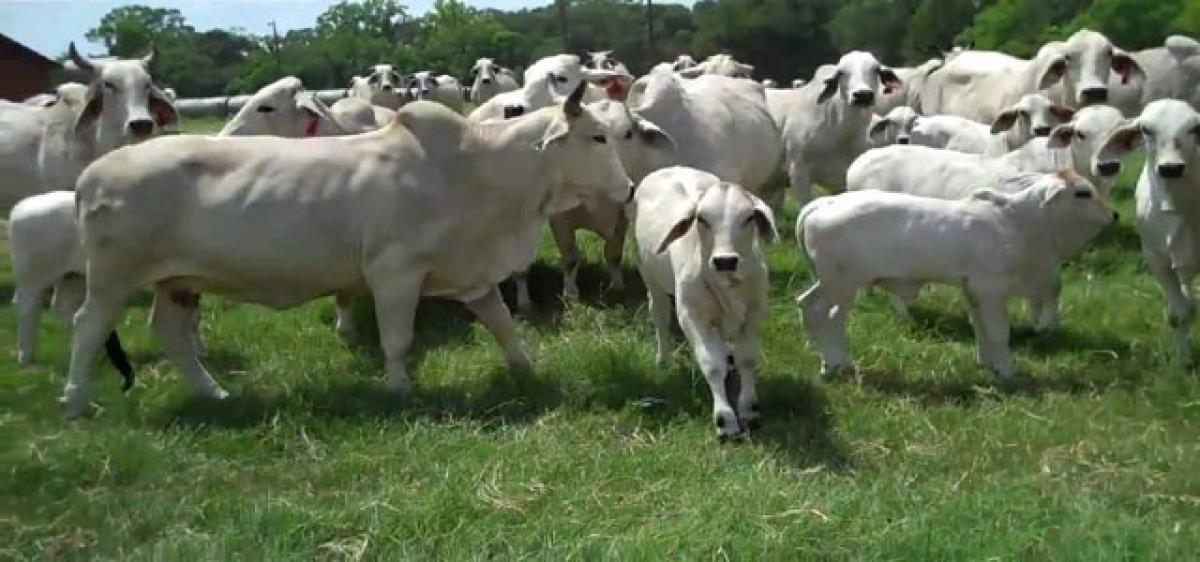Ongole breed in death throes due to fodder scarcity

The Ongole breed cattle, which is known for its toughness, longevity, tolerance to high temperatures and diseases, is struggling for existence in its own home.
CATTLE BATTLE FOR survival
Ongole: The Ongole breed cattle, which is known for its toughness, longevity, tolerance to high temperatures and diseases, is struggling for existence in its own home. Those farmers, who have treated the cattle as their family members, are now selling them for a nominal price unable to feed them due drought situation.
Ongole breed cattle are popular in western countries for its meat, but here, the breed caters to agriculture and dairy related needs. Ongole Bulls are masculine and capable of working for long hours in dry land under hot atmospheric conditions. So the local farmers harness the male animals for agriculture and the female animals for milk.
But mechanization has killed the need of bulls in agriculture in many places including drought hit Prakasam district. Ponugoti Tirumala Reddy of Kothapalli village in Konakanamitla mandal of Prakasam district said, “Due to the continuous drought in the district, the farmland has become dry and there is not enough fodder for the animals.
We should buy the fodder by spending an average of Rs. 2000 per animal every month. When the farmers are unable to take the burden of about Rs. 10000 for the animals, they think of selling them or ration the feed at first. The animals lose their muscle power gradually and become lean and emaciated. When we try to plough our fields with these animals, it takes more time and also more physical efforts from the farmers.
When the farmer is unable to make a living on agriculture due to the non-availability of minimum support price and his increased debts, he makes up his mind to sell the animals first. Though he knows that the animals he loved as his family members would be sent to slaughterhouses, he has no other option but to sell the animals for a nominal price.”
The dairy farmers also do not want Ongole breed females as they do not produce more milk. Vaka Satish Kumar Reddy, a dairy farmer in K Uppalapadu said, “We should spend Rs. 70000 to 80000 to purchase a calf and bear expenditure until it starts producing milk. But the Ongole breed animals give only 2 to 3 liters of milk while the other breed animals like Jersey, Holstein Friesians (HF), Goldstone and others produce 10 to 25 liters of milk depending on the breed.
Though the expenditure on the other breeds is slightly higher than the Ongole breed, it is negligible with the returns we make on them.” Under various schemes like Kamadhenu and Ksheerasagar, the government is supplying silage grass on subsidy at Rs. 2 per kg. An animal should be fed about 20kgs of grass per day to produce 3 to 4 liters of milk. Medical care is also being provided to calves and pregnant cows.
Farmers are now requesting the government to their rescue in providing fodder and water to the cattle. Krishna Rao of Nagireddy Palle in Veligandla mandal, where the government supplies just 30 liters per capita per day said that farmers used to believe that keeping cows in home brings prosperity. “But we are selling them unable to withstand the hardships.
It is very disheartening to sell the animals and see them silently board the trucks. But in such situations of drought when the people also do not have sufficient water, how can we feed the animals? If the government could provide fodder on full subsidy and make arrangements for water, we need not fear about the future.”
On the other hand, the government is encouraging scientists to strengthen the breed and increase milk production capacity. Scientists at the government cattle breeding farms at Chintaladeevi in Nellore district and Chadalawada in Prakasam district are working on increasing the productivity of the breed.
Dr Ramesh Naik at Chintaladeevi Composite Livestock Farm said, “The government has launched an Ongole breed male calf breeding program recently. We provide 90 per cent subsidy to 70 beneficiaries to purchase 3-month old calves. We further take the responsibility of providing fodder and medical requirement for them up to 2 years.
By Nandam Naresh

